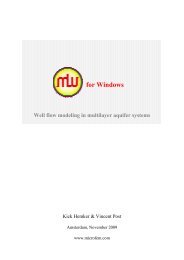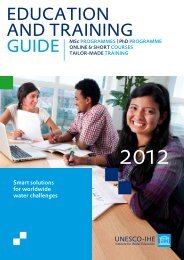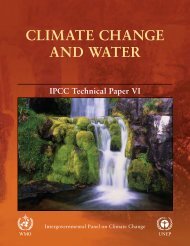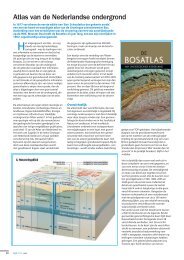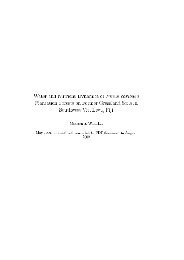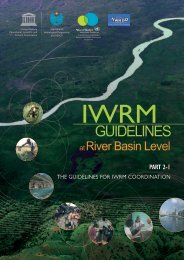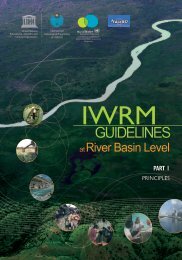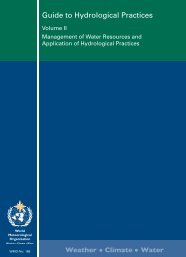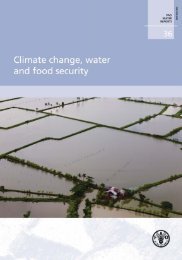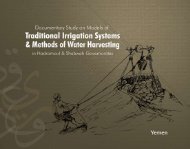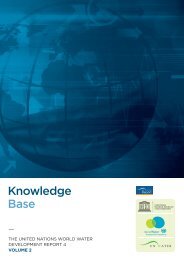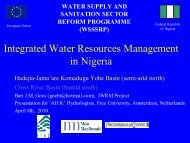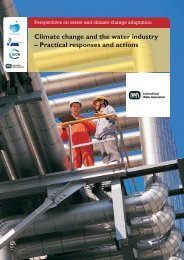Non-renewable groundwater resources: a ... - unesdoc - Unesco
Non-renewable groundwater resources: a ... - unesdoc - Unesco
Non-renewable groundwater resources: a ... - unesdoc - Unesco
- No tags were found...
You also want an ePaper? Increase the reach of your titles
YUMPU automatically turns print PDFs into web optimized ePapers that Google loves.
NON-RENEWABLE GROUNDWATER RESOURCESsimple continuation of the existing rates, at least within the CT, thus, would be completely unacceptablefor the Chotts region. There, the reduction of withdrawals must be seriously contemplatednow and on into the future. Salinity intrusion in the CT would be very harmful.Simulations considered the possibility of bringing the level of exploitation up to 7.8 billionm 3 /year within 50 years. This can be done only at the cost of dispersing new fields. 80% ofthe additional withdrawals will have to be done within distant areas, i.e., the CI’s Western Basinand the CT’s Oued Mya in Algeria. This will provide a total exploitation, by country, of 6.1 billionm 3 /year in Algeria, 0.72 billion m 3 /year in Tunisia, and 0.95 billion m 3 /year in Libya. This possibilitywould cause exploitation of the NWSAS to climb to a level equivalent to eight times its<strong>renewable</strong> <strong>resources</strong>. Such an operation is realizable only by considerable drawing upon the system’sreserves. <strong>Non</strong>etheless, the necessity of confirming the results obtained must be stressed. Inspite of the progress realized by the NWSAS project, uncertainties remain and these will requirenew investigations.The new hydrogeological knowledge together with the simulation model makes it possibleto predict the capacities of the NWSAS to supply appreciable quantities of water while minimizingrisks concerning the resource. The results obtained show that it is advisable to managethis resource jointly. The intention of planning this joint use has been advocated by theOSS since the launching of the project: to promote a basin consciousness and to implement adialogue mechanism.Consultation and cooperation mechanisms72The simulations carried out have highlighted the areas where shared <strong>resources</strong> appear to be themost vulnerable. The exploitation of the Complex Terminal today, and of the ContinentalIntercalary tomorrow, will undoubtedly lead the three countries Algeria, Tunisia and Libya toconsider sometime in the future the joint control, and reduction, of the pumping. How to controlthese flows through a concerted policy of preserving the water <strong>resources</strong> for the mutualbenefit of all the countries over time is the central question that needs addressing today. Thisdialogue has begun.Everyone acknowledges the major risk of a deteriorating resource as a consequence ofoverexploitation. This has forged a partnership throughout the NWSAS of technical teamsconvinced that common action increases the effectiveness of solutions, and the certainty thatinformation exchange is not only possible but also necessary.As such, the OSS, through the NWSAS project, has developed a database containing allpresent and historical information on all water points, their levels, and their flows. This databaseis operational and accessible to the three countries. In this respect, the goodwill of the threewater authorities in the communication of information has been exemplary. Moreover, theNWSAS Model is available and operational within each of the three countries. A mechanism isneeded to guarantee the maintenance, the development and the permanent updating of twotools – the Database and the Simulation Model.In addition to the maintenance of the database and model, the three countries have agreedto the regular exchange of data and information. This data exchange serves as a basis for the formulationof common policies and strategies, including:a) the necessary continuation of the NWSAS project’s work on improving knowledge of thesystem and of its exploitation,



